
36 minute read
News
Feds moving ahead with single-use plastics ban
The Canadian government unveiled a far-reaching plastics waste plan in October that will ban a wide range of single-use plastic products and move the country towards mandates for recycled content, producer responsibility, and tighter regulations of other plastics.
The plan will also seek to add “plastic manufactured items” to Schedule 1 of the Canadian Environmental Protection Act, which could declare them toxic.
The proposed ban covers many of the most commonly used non-reusable plastic products, while other items will be exempted. Single-use items covered by the ban will include carry-out bags, stir sticks, beverage six-pack rings, cutlery, straws, and food packaging made from any plastics defined as being hard to recycle. Single-use plastic products not covered by the ban include garbage bags, milk bags, snack food wrappers, disposable personal care items and their packaging, beverage containers and lids, contact lenses and packaging, cigarette filters, items used in medical facilities, and personal protective equipment.
The Liberal government first promised to ban single-use plastic items last year, but steps in that direction were delayed by the outbreak of the COVID19 pandemic. The government recommitted to the idea in its September 2020 throne speech. The bans are part of the government’s plan to achieve zero plastic waste by 2030.
The announcement in October also Mahone Bay, N.S.-based RPS Composites Inc., a manufacturer of fibrereinforced plastic and dual laminate piping systems, has acquired the assets of Fabricated Plastics Ltd. in Maple, Ont., to add tank fabrication to its capabilities and expand capacity.
The terms of the acquisition have not been disclosed.
Founded in 1962, Fabricated Plasincluded a proposal to establish recycled content requirements in products and packaging, which the government says will spark investment in recycling infrastructure and innovation in technology to extend the life of plastic materials to keep them in the economy, and out of the environment for longer.
The government has set a target of achieving at least 50 per cent recycled content in plastic products by 2030, and under the new regulations the government will require a minimum percentage of recycled content, rules for measuring and evaluating the amount of recycled content, and guidelines and related tools to help companies meet their requirements.
INDUSTRY ASSOCIATIONS PUSH BACK But the Ottawa-based Chemistry Industry Association of Canada (CIAC) – which recently merged with the Canadian Plastics Industry Association – has come out against the proposed bans and urged the government to give time for plans being developed to modernize recycling systems across the country, including with national waste legislation. “CIAC supports the development of national waste legislation that will provide the appropriate authorities and the tools to support advancing a circular economy for plastics,” it said in a statement. “Our goal, as a society, must be to properly manage and establish a circular economy for all plastic products.” tics produces vessels and tanks up to 30 feet in diameter and 60 feet high, and which are used by the chemical processing and pulp and paper markets, as well the mining, semiconductor, food and drug, and electroplating industries.
The company will now operate under the RPS Composites group as RPS Composites Ontario Inc.
In particular, CIAC urged the government to delay the plan to list plastic products as toxic. Elena Matagaris, vice president of the plastics division of the CIAC, said in a report that “plastic products don’t belong anywhere near a list of harmful products that includes mercury, asbestos, and lead. It’s a criminal-law tool and it’s intended to manage toxic substances. Plastic is an inert material – it’s not toxic.” Matagaris said that branding plastics as toxic will cause “reputational damage to [the] sector [and] that’s not fair game.”
Other industry associations that have raised concerns about the policy, and the designation of plastic as a toxic substance, include Canadian Manufacturers & Exporters, Restaurants Canada, and the U.S.-based groups Plastics Industry Association
Nova Scotia pipe producer RPS acquires Fabricated Plastics’ assets
and Vinyl Institute. CPL
“[Fabricated Plastics’] commitment to safety and product quality aligns with our RPS values, and the product lines, that include ASME RTP-1 certified tanks and vessels, are an excellent strategic fit for RPS,” RPS CEO Jeff Fraser said in a statement. “We are excited by what this expanded capacity means for our current and future customers.” CPL
Plastics machinery shipments continue to fall in 2020
Plastics machinery shipments in North America continue to slump in 2020, according to the latest statistics from the Plastics Industry Association in Washington, D.C.
According to the association’s committee on equipment statistics, the preliminary estimate of shipments value from reporting companies totalled US$263.4 million in the second quarter, a drop of 10.7 per cent from the same period a year ago – a larger drop than the committee reported in the first quarter of 2020. In May, it reported that first quarter shipments had fallen 6.9 per cent compared to the same period in 2019, to US$254 million.
The committee highlighted that the 2020 second quarter was up four per cent compared with the first quarter.
“Although primary plastics machinery shipments are still lower than the previous quarters, the second quarter uptick is consistent with gradual improvement in the U.S. economy,” Perc Pineda, chief economist with the Plastics Industry Association, said in a news release.
The machinery data includes injection molding and extrusion equipment. The value of shipments of single- and twin-screw extruders fell 35.8 per cent and 30.1 per cent, respectively, in the second quarter. Shipments of injection molding equipment were down 8.5 per cent compared to the same quarter a year ago.
Plastics machinery exports in the second quarter totalled US$289 million, while imports rose by 15 per cent to US$649.5 million, resulting in a trade deficit of US$360.5 million, which is down nine per cent compared with the second quarter of 2019.
Canada and Mexico remain the top export markets for U.S. equipment suppliers. Combined exports to the USMCA trade partners totalled US$134.5 million, representing 46.5 per cent of total U.S. plastics machinery exports in the second quarter. CPL
New CEO at Magna in 2021
Canadian automotive parts supplier Magna International Inc. has named Seetarama (Swamy) Kotagiri, 51, as its next CEO, effective Jan. 1, 2021.
The 21-year veteran of the Aurora, Ont.-based
Swamy Kotagiri Photo Credit: Magna International Inc. company will succeed Don Walker, 64, who will retire at the end of 2020.
“Given Swamy’s role in aligning the company’s strategy with the megatrends impacting new mobility and the ‘car of the future,’ he is the right leader to take Magna forward,” William Young, chairman of Magna’s board of directors, said in an Oct. 20 statement.
Kotagiri is currently Magna’s president, and previously served as the company’s chief technology officer and as president of Magna Electronics, Magna Powertrain, and the firm’s power and vision segment; he also held earlier engineering and operating positions at Cosma International, a Magna operating unit. He holds a master’s degree in mechanical engineering from Oklahoma State University with a specialization in materials and structural engineering.
Walker’s career at Magna spans 33 years, with the last 15 as CEO, his second stint in the role. He also served as CEO of former Magna unit Intier Automotive, its interiors business, between 2001 and 2005. He also was CEO of Magna between 1994 and 2001. CPL M. Holland co-founder Joan Holland passes away Joan Holland, co-founder and chairperson of the board emeritus at Northbrook, Ill.-based resin distributor M. Holland Co., died in Chicago on Sept. 8 at age 91. Photo Credit: M. Holland Co.
Along with her late husband Marvin Holland, she founded the firm in 1950 from the couple’s apartment in Chicago with several hundred dollars she had saved. The company grew from a small, regional plastic resin distribution company into an international business with customers throughout North and South America and Europe; along the way it moved into a 160,000-square-foot warehouse in Chicago in 1990, expanded into Canada with the founding of M. Holland Canada Co. in 2004, and expanded into Mexico in 2015. M. Holland currently sells more than US$1 billion of materials to more than 4,000 customers annually.
After Marvin Holland’s death at age 70 in 1994, the couple’s son Edward became the president and CEO and Joan Holland assumed the role of chairperson. CPL
Ontario molder Innotech gets government funding for innovation
Toronto-based automotive parts manufacturer Innotech Precision Inc. is receiving $98,582 in funding from the Ontario government to help improve efficiency, productivity, and build capacity.
The funding is part of the Ontario Automotive Modernization Program and will be matched 1:1 by Innotech.
Innotech provides tooling, engineering, and injection molded components for the automotive industry. The funding will go towards implementing real-time automated monitoring systems, which includes vision and production data analytics technology. The investment will also improve manufacturing efficiency and support sales growth. The project is expected to lead to the creation of six new jobs while helping to retain 53 jobs at the company. CPL
Calgary-based Nova Chemicals Corp. has sold its expandable styrenics business to Mexican conglomerate Alpek SAB de CV for an undisclosed price.
The sale includes manufacturing plants in Painesville, Ohio, and Monaca, Pa. The business being acquired makes expandable PS resin and Arcel-brand styrenic copolymers, which are used in packaging, construction, cups and containers, and other markets.
In an Oct. 19 statement, Nova officials said that the sale is an important step in the firm’s plan to focus on its olefin and PE business. “This transaction provides us with immediate cash generation to further strengthen our balance sheet and focus on the safe and successful completion and start-up of our world-class Advanced Sclairtech technology facility under construction in [Sarnia,] Ontario,” Nova president and CEO Luis Sierra said in the statement.
Monterrey, Mexico-based Alpek is a global supplier of PET and purified terephthalic acid, and a supplier of expandable PS and recycled PET in the Americas. The firm operates 28 plants in Canada, the U.S., Mexico, Brazil, Argentina, Chile, and the U.K., and employs more than 6,000 workers.
The sale is expected to close in the fourth quarter of 2020. CPL
SUPPLIER NEWS
– PolyExpert Inc., a Laval, Que.-based manufacturer of extruded blown film, has attained Safe
Quality Food (SQF) certification. Recognized by the Global Food Safety Initiative, the SQF certification is designed to meet industry, customer, and regulatory requirements for all sectors of the food supply chain, from farm to retail stores. PolyExpert manufactures LDPE, LLDPE, and HDPE films in single- and multi-layer versions for markets such as lamination, foods packaging, multi-wall paper bags, and agricultural (mulch) films.
– Chemical maker Solvay has appointed Vanderbilt
Chemicals LLC as the distributor of its Tecnoflon fluoroelastomers (FKM) and perfluoroelastomers (PFR FFKM) in North America. Headquartered in
Norwalk, Conn., Vanderbilt is a wholly owned subsidiary of R.T. Vanderbilt Co. Inc. Solvay’s family of Tecnoflon FKM and PFR FFKM products are designed for use in sealing applications in aggressive chemical and high-heat environments, such as those found in the automotive, industrial, semiconductor, and energy industries. PEOPLE
Barry Arkles Mike Crosby
Glenn Munshaw
Jeff Smink Cathy Dodd Greg Gumbs
Chris Hartwick
John Inks Uwe Peregi Paul Tayler
Jonas Wästberg
– Morrisville, Pa.-based specialty chemical maker
Gelest Inc. has appointed Barry Arkles as CEO. – McHenry, Ill.-based specialty colourant and additive supplier Chroma Color Corp. has named Mike
Crosby as vice president and general manager of its
Epolin business unit, Glenn Munshaw as vice president of operations, and Jeff Smink as vice president of technology. – Avon Lake, Ohio-based thermoplastic resin supplier
Avient Corp. has named Cathy Dodd as senior vice president, president of distribution. – Charlotte, N.C.-based factory automation supplier
Bosch Rexroth North America has appointed Greg
Gumbs as president and CEO effective Dec. 31. He replaces Paul Cooke, who is retiring. – Mississauga, Ont.-based pipe extruder Uponer Canada has named Chris Hartwick as general manager. – Engineered thermoplastics and custom packaging solutions provider Spartech LLC, headquartered in
Avon, Ohio, has appointed John Inks as CEO. – Bartlett, Ill.-based welding systems maker Herrmann
Ultrasonics Inc. has named Uwe Peregi as president. – Thermoplastics resin distributor Nexeo Plastics, headquartered in The Woodlands, Tex., has named Paul
Tayler as CEO. – Bredaryd, Sweden-based recycling equipment manufacturer Rapid Granulator Group has named Jonas
Wästberg as CEO.
The ins and outs of extruding RECYCLED PLASTICS
Many extrusion shops want to use recycled plastics these days, but there are issues involved, including material variability, contamination, and moisture. So it’s a good thing that OEMs are offering systems tailored to overcome these challenges.
By Mark Stephen, editor
Photo Credit: Entek Extruders
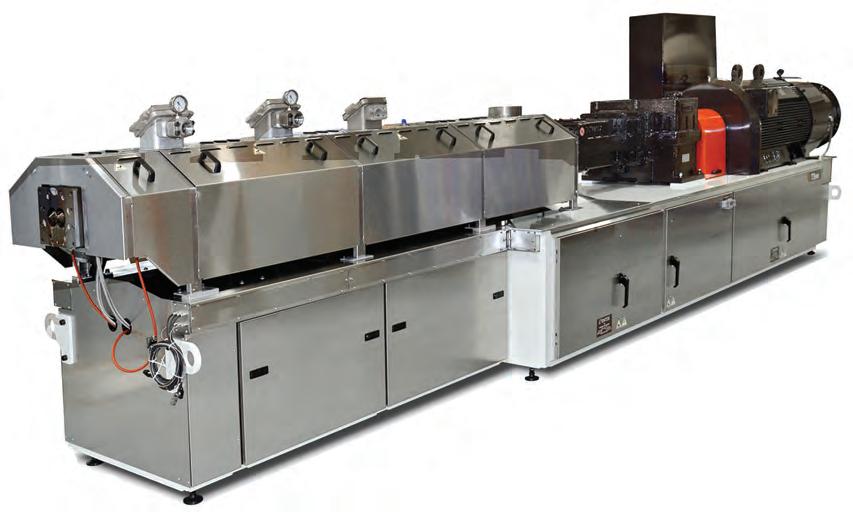
Money never sleeps, the saying goes, and neither does concern for the environment, even during a global pandemic. For plastics processors, this means continued – even growing – interest in plastics recycling so that customers can market their products as environmentally-friendly, especially during the V-shaped economic recovery we all hope is coming.
And this interest definitely carries over into extrusion shops. But the catch is, extrusion machines must overcome challenges particular to using recycled materials, which means primarily contamination, degassing, moisture, and corrosion. The good news is, a growing number of extruders are being designed to handle post-consumer materials.
KEY QUESTION “We’re seeing a lot of interest from all kinds of companies in recycling applications, even from virgin resin manufacturers,” said Monika Gneuss, vice president of sales and marketing manager with Gneuss Inc. “Some projects have slowed somewhat since the pandemic started, but many are still going forward full steam.”
Since processors that use recycled plastics have special needs that require customization, it’s important for OEMs to know this in advance before recommending an extrusion solution.
“Regardless of who the customer is,
we need to know exactly what they want to run, whether it’s recycled materials or traditional resins,” said Kevin Slusarz, director of process technology with US Extruders. “If they want to run a range, as with custom profile houses, we’ll make our solution more generic so that it runs a breadth of materials and/or recommend multiple screws, or different screws, for various groups of resins.”
According to Adam Dreiblatt, director of process technology for CPM Extrusion Group, when it comes to corotating twin-screw extruders, there are some requirements for processing recycled resins that are more difficult to implement after the line has been installed. “Extending machine length to add venting capacity, or moving side feeders or changing feed positions are examples,” he said.
A big question at the outset – perhaps the biggest – is, what’s the source of the recycled material? “The big distinction we want to know is whether the extrusion customer is buying treated recycled material from a vendor or using their own in-house regrind,” Kevin Slusarz said. “Typically, recycled material is prepared in the reprocessing extruder: it gets washed, size reduced, extruded, vented, pelletized, and then sold to the open market, whereas customers that are using their own recycled material may or may not be pelletizing it.” For this latter category, Slusarz continued, there are options. “We might recommend upgrading the materials of construction – upgrading the barrel to an Xaloy X-800 or the equivalent, which is for abrasion resistance; and using Colmonoy 83 to protect the flight, which is a nickel-chromium-tungstenboron matrix alloy containing chromium carbides with the addition of extremely hard tungsten carbide particles,” he said.
UNEQUAL PLAYING FIELD A key point is that – whatever the laws or other legal mandates say – all recycled material is not recreated equal. “There’s a difference between postindustrial and post-consumer recycle,” said extrusion consultant Alan Griff, head of consulting firm Griffex. “Known post-industrial should have more value if consistent in viscosity as well as appearance. Purchase should have such specifications, which is easy to say, but also easy to forget in the face of a lower price.”
Which means that extrusion shops should test incoming materials (and
Water Chillers
Portable Chillers : .25-40 tons Indoor Portable Chillers ... Air or Water Cooled
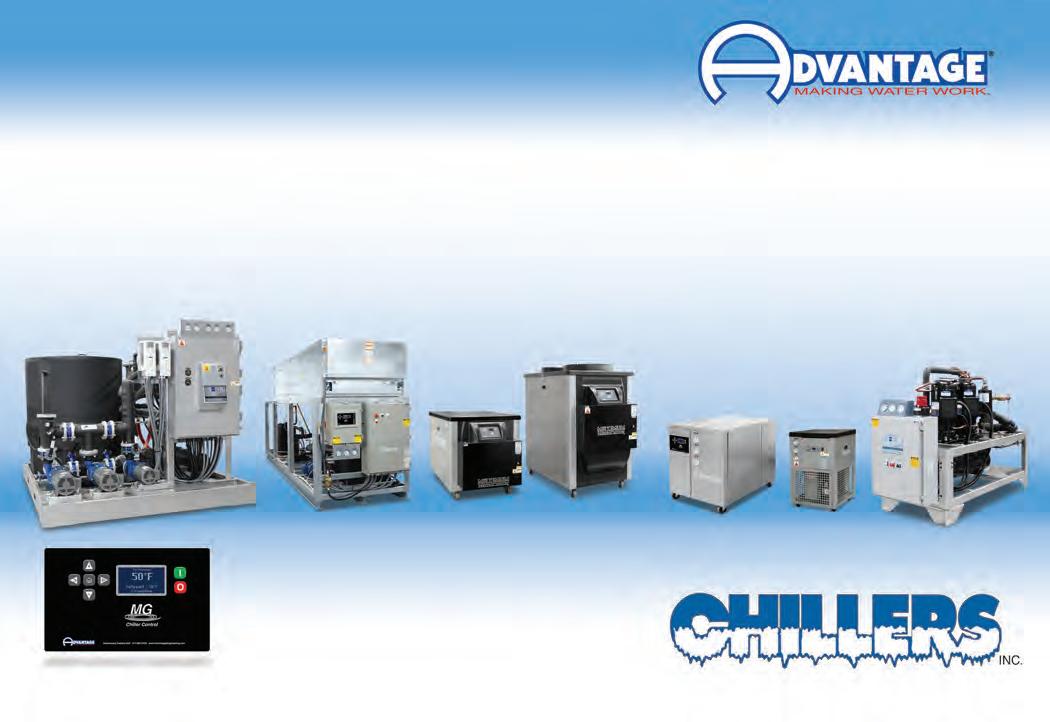
Central Chillers : 5-180 tons Indoor & Outdoor units ... Air or Water Cooled Complete chiller & pump system packages or stand alone chilling modules.
NEW MG Portable Chiller Control System
905-895-9667
Portable & Central Chillers Manufactured by Advantage With Exclusive Canadian Distributor, Chillers Inc.
www.ChillersInc.com 1228 GORHAM STREET, UNIT 11 NEWMARKET, ONTARIO L3Y 8Z1
share the results with OEMs) so they can see problems ahead and deal with them. “Each recycled stream needs to be evaluated for content of contamination, bulk density, shape, and material flow,” said Paul Godwin, president and CEO of battenfeld-cincinnati USA. “The final design of the processing and auxiliary equipment can then be selected to best suit the material.”
Contamination consisting of metal, labels, paper, and foil might be the most common problem when extruding recycled materials, but there’s other types of contamination to be aware of, as well. “There’s also the issue of polymer contamination – for example, if there’s nylon in PP, the nylon has a higher melting point, so it will end up contaminating the screens quicker,” said Dean Elliott, technical processing manager with Entek Extruders. Which is why, depending on the level of contamination, specialized screen changers with large surface areas designed for recycling are sometimes necessary, OEMs say.
And for recycled material with a high potential for contamination, the right screening becomes critical. “Fortunately, there are a lot of options, ranging from no screening at all — clean feed, less critical end-use — to very fine screening, a way of adding more value to the material,” said Alan Griff. “The finer the screening, the faster the screens will clog and the more often they’ll need to be changed.” The heat stability and viscosity of the plastic also matter, Griff continued. “If the plastic can take more heat, the screens can be left in longer,” he said. “Greater contamination buildup increases back pressure in the extruder and draws more power from the motor, which may generate more frictional heat in the screw.”
Recycled resin with a high level of contamination requires significant melt filtration to produce an acceptable compounded product. “If the extrusion line isn’t equipped with a suitable screen changer, the frequency of changing screens can become unwieldy,” Adam Dreiblatt said. “Specialized high-area screen changers and continuous filters have been designed specifically for heavily contaminated recycling applications.”
And while the choices of different types of screen changers are quite extensive, this will only get you so far – after which the possibility of using different materials of construction again enters the equation. “Screen changers certainly play a very impor-


The days of overpaying for high-end molding solutions are over. Our fast-cycle and multi-component solutions are now available in North America.
ZE - MULTI Electric Multi-Shot
• Horizontal “L” • Vertical • Parallel

• Piggyback • Opposing
ZERES - F Electric Fast-Cycle

Electric high-speed thin-wall solution without the large capital investment
MARS - F Servo-Hydraulic Fast-Cycle
Servo-hydraulic packaging solution with 500 mm/s injection speed and parallel functions
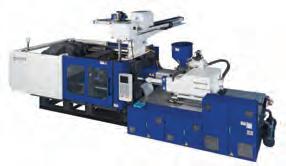
Contact Absolute Haitian for new machine sales at 216-452-1000 or sales@absolutehaitian.com.
tant role in recycling, but as they’re after the extruder, they won’t ‘protect’ the extruder or mitigate processing issues,” said Monika Gneuss. “Extruders will certainly wear faster when processing recycled materials with solid contamination, so one design change might be using different materials of construction, for example bimetallic barrels. With our MRS extruder, the whole multiple screw section is vented to make for very efficient devolatilization.”
CONSISTENTLY INCONSISTENT A lack of material consistency is another characteristic of some recycled resins, especially when extrusion shops buy recycled plastics from a variety of sources as opposed to reusing their own material through a closedloop recycling system. Since the goal is to produce the same properties, one way to achieve this is if processors of recycled plastics combine material from numerous lots prior to processing to improve consistency, although a downside is that this step requires significant floor space to store resin and large blenders to combine it.
According to Paul Godwin, one way to overcome lot-to-lot variation in melt flow is to run a controlled blend of differing melt index materials to nominalize the variation to the extrusion process. “With large swings in melt index the process conditions may need to be adjusted to obtain a quality extrudate,” he said. Other options are also available. “Some customers that run recycled resins change dies in order to compensate for the change in viscosity,” Kevin Slusarz said. Changes in operating conditions such as screw speed and temperature settings can also homogenize the mix. Gneuss’ MRS extruder – which was developed specifically for recycling applications involving PET but can also be used with other materials – is said to be a good fit for this type of application. “Our MRS extruder offers excellent distributive mixing properties that help homogenizing viscosity variations not A VALUABLE DIGRESSION ON MELT SCREENS… As our main article makes clear, recycled resins have a high potential for contamination, which means that melt screening – which is important enough when processing traditional resins – now becomes critical.
And as extrusion expert Alan Griff explains, there’s a range of options available for screening recycled materials, as well as several points to keep in mind. “Some screeners continuously sweep the screen and remove contaminants; others have two parallel paths so one can stay in use while the other is changed; some are completely manual while others have hydraulic or pneumatic assist or quick change; and some run a continuous strip of screen or ring of screens that move around so resistance (thus back pressure) remains more or the less the same,” he said. “Screening also requires attention to screen material, weave (square, Dutch), wire thickness (gauge), mesh (wires per inch or centimeter), and use of a screen pack (a sandwich of several screens of different or the same mesh and wire sizes).”
just for PET but also when recycling polyolefins,” said Monika Gneuss.
Achieving homogeneity is especially problematic for the compounder to produce consistent properties when adding various lots of recycled resins – a problem made worse nowadays as lot sizes have become smaller with just-in-time operations. “The compounding parameters to reach a specified property will be different for resins having higher or lower melt flow; running all at the same processing conditions will then result in compounds having a wider range of properties, both within-lot as well as lot-to-lot,” said Adam Dreiblatt. “In order to produce consistent quality while maximizing the percentage of recycled resin, the variability needs to be reduced on one end or the other. This means preblending large lots of resin or large lots of compounded product, either of which adds cost.”
THE NEED TO VENT To deal with moisture and volatiles in the melt, meanwhile, compounding extruders used for recycled plastic can benefit from additional venting. Traditional extruders that handle traditional petroleum-based plastics that are being compounded with various additives usually have one vent; co-rotating twin-screw extruders offer the flexibility to add venting, making them good fits for running recycled materials. “For recycled polymers, it’s not uncommon to see two or three vents on the extruder,” said Dean Elliott. And if the machine wasn’t initially configured for venting of a high percentage of volatiles, additional vents or different vent geometries can be added or installed. “These aren’t significant modifications but they do carry some capital cost,” Adam Dreiblatt said.
Another option is to use vent stuffers, which push materials back into the extruder process section while allowing gases to escape. “Adding a vacuum vent stuffer to manage the additional volatile load for an existing vent has become very popular over the past few years with increasing use of recycled resin,” Dreiblatt said.
In the end, because recycled plastics vary in size, form, bulk, quality, and consistency, making the right extrusion technology choices are critical to ensuring the best product quality. But it’s definitely doable, especially if you bring the OEM into the process at the beginning. CPL
RESOURCE LIST battenfeld-cincinnati USA (McPherson, Kan.); www.battenfeld-cincinnati.com; 620-241-6843 CPM Extrusion Group (Traverse City, Mich.); www.centuryextrusion.com; 231-947-6400
Entek Extruders/Entek Manufacturing Inc.
(Lebanon, Ore.); www.entek-mfg.com; 541-259-1068 Gneuss Inc. (Matthews, N.C.); www.gneuss.com; 704-841-7251 Griffex (El Cerrito, Calif.); www.griffex.com; 301-758-7788 US Extruders (Westerly, R.I.); www.us-extruders.com; 401-584-4710
THE BIG THREE OF CHEMICAL RECYCLING In the quest to create virgin-quality regrind for packaging applications, the chemical recycling options of pyrolysis, solvent dissolution, and chemical depolymerization are leading the way.
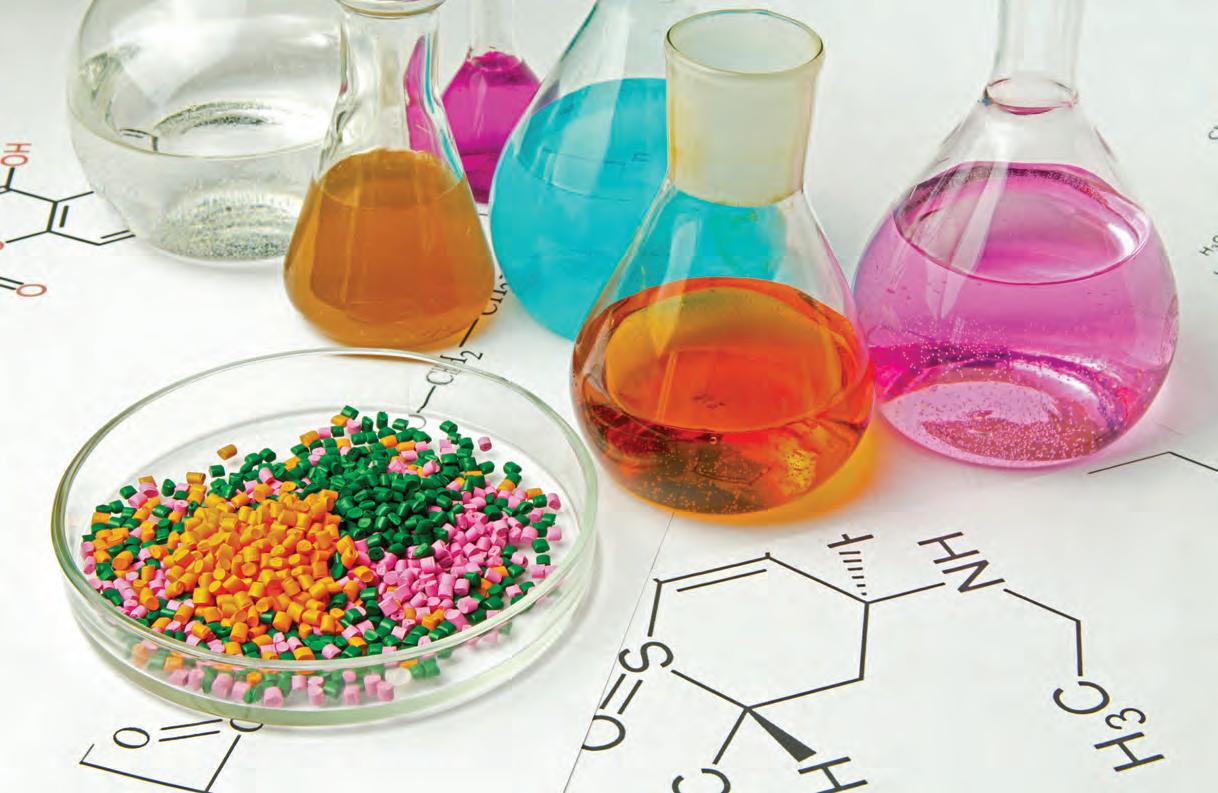
By Mark Stephen, editor
No matter what the human endeavour, there’s usually a “Holy Grail” at the end of it – something you want very much but that’s very hard to achieve. For climbers, it’s ascending Mount Everest; for golfers, it’s potting a hole-in-one. And so on.
For the waste plastic packaging sector, this ultimate quest involves turning the waste back into truly virgin-quality recycled material for use as new packaging materials.
The problem is, this leaves mechanical recycling – the standard method widely used today, involving sorting, washing, and extrusion to produce a pellet used as a secondary raw material – out in the cold, since it can’t produce a virgin-comparable product. Which is why traditional mechanical recycling typically downcycles into applications with less-exacting specifications than what the virgin materials were designed for.
Chemical recycling offers an alternative. Also called advanced plastics recycling, the process converts post-use plastics to their original monomer forms so they can be remade into new plastic materials that are identical to the originals. Primarily, three different types of chemical recycling are being developed for recycling packaging into virgin-quality polymers: pyrolysis, solvent dissolution, and chemical depolymerization. Each uses a different process and is suitable, or has been developed, for different polymers.
Here’s how each of the Big Three works.
PYROLYSIS Pyrolysis uses a thermal cracking process to convert plastic waste to an oil, which is often further purified and then used as feedstock in the production of base chemicals – for example, ethylene, which is used for polymer production.
Although researchers are trying to develop technologies that accept all kinds of mixed waste, it’s likely these materials will have to be sorted and cleaned before they can undergo pyrolysis. Potentially, new virgin-quality polymer can be made from the resulting oil. The process is particularly relevant for PE because LDPE is so widely used in film. Mechanical recycling of film is challenging, however, and putting recycled content back into film is considered to be very difficult.
The pyrolysis method has sparked industry collaboration since the process produces base chemical products that can be used across multiple polymer segments. Even the by-products of pyrolysis are finding purpose, as seen in the collaboration between polymer supplier Ineos Styrolution and Brantford, Ont.-based GreenMantra Technologies. GreenMantra’s approach converts PS waste directly into marketable products, and Ineos is working to purify GreenMantra’s byproduct stream to recover styrene monomer for polymerization into recycled PS resin.
SOLVENT DISSOLUTION Differing from pyrolysis in that the polymer isn’t broken down, solvent dissolution involves selective extraction of polymers using solvents. A relatively pure feedstock, such as washed PP from margarine tubs and other packaging, is dissolved in a solvent. Once dissolved, the process can mechanically and chemically separate colourants, additives, and contaminants before finally separating the original polymer
from the solvent. The end-product then becomes a cleaned polymer that can be used as new raw material resin again.
The process has pros and cons. A major benefit is that it can be used to create food grade recycled rPP, and can also be used to recover PE or PP from multi-layer, non-recyclable packaging. On the down side, solvents can be expensive, and the more non-target material present, the higher the cost of recycling owing to potential solvent loss; and the process is considered to be technically challenging to develop and operate.
In Canada, Montreal-based Polystyvert Inc. uses solvent dissolution in a three-step system: first, the PS is placed in contact with an essential oil that dissolves it in seconds; second, the mixture of dissolved PS and essential oil is purified and the PS separated and removed; third, the final recycled product is pelletized, while the essential oil is also recycled for the next dissolution cycle.
CHEMICAL DEPOLYMERIZATION Chemical depolymerization provides the ability to break down a polymer into either monomers or intermediates – the individual building-block molecules – for what proponents say is unparalleled separation, purification, and recovery of plastic materials.
Similar to solvent recycling, the process removes additives and colourants while contamination is filtered out. The resulting product is a plastic raw material (monomer) that’s nearly identical to material sourced from traditional fossil fuels, which means the depolymerized material could then be used for food contact applications.
The process is being developed primarily for PET, which can be broken down using either water (hydrolysis) or monoethylene glycol (glycolysis). And since PET is used almost exclusively in fibre and packaging, chemical depolymerization offers significant recycling advantages. Researchers say that PE and PP can’t be broken down in such a controlled way since the polymer chain doesn’t have any distinctive “cutting points.”
Challenges to chemical depolymerization include the need to prepare the feedstock to remove as much contamination as possible; and cost, as the process is more expensive than generic mechanical processes because of adding the chemical step to collection, sorting, washing, and shredding operations.
One of the companies embracing depolymerization is Ineos Styrolution, which is partnering with green technology supplier Agilyx to build a new facility near Chicago that will eventually recycle up to 100 tons of PS per day. CPL
Factor
The X Factor is Value.
• Reduced cycle time • Increased precision • Improved gripper designs • Application flexibility • More productive uptime
Experience Full Control
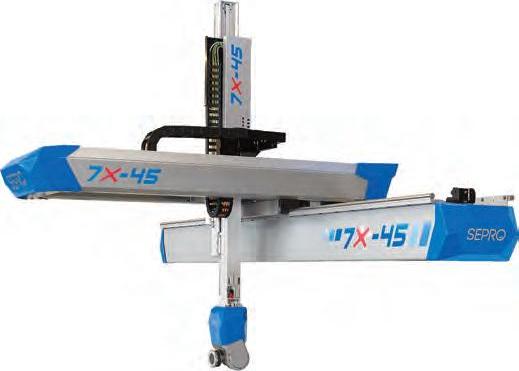
VISIT SEPRO’S VIRTUAL SHOWROOM!
http://bit.ly/SEPRO-VSR-NA The servo wrist adds value in any application!
www.sepro-group.com • seprocanada@sepro-group.com • 514-515-9349 • @SeproGroup l
NOVA AND MERLIN PLASTICS PARTNER TO USE CURBSIDE RECYCLING FOR CONSUMER PACKAGING
Calgary-based Nova Chemicals Corp. has announced a long-term agreement with Merlin Plastics Supply Inc., said to be Canada’s largest plastics recycler, that will see Nova offer PE resins containing post-consumer recyclate (PCR).
The agreement marks Nova’s first foray into buying PCR and offering it for sale to its customers.
Under the deal, Nova will provide Vancouver-based Merlin with financing for a multimillion-dollar project to expand its processing plant in Delta, B.C. The investment will enhance Merlin’s processing of PCR for food packaging applications, with commercial quantities expected to be available beginning in 2021. Nova will buy up to 30 million pounds of the PCR per year.
Many of the world’s leading consumer brands have pledged to increase the amount of PCR content in plastic packaging to an average of 25 per cent by 2025, but today’s recycled PE is still mostly used in non-food applications such as detergent bottles and plastic lumber. Nova’s partnership with Merlin aims to change this by turning HDPE plastic recyclate into resin for use in everyday products, with


Inside Merlin’s Delta, B.C. plant.

an emphasis on food packaging applications. “We expect demand for PCR to increase tenfold in the next five years based on brand owner sustainability commitments,” said Greg DeKunder, Nova’s vice president, marketing. “We’re excited to continue successfully working with our customers on application development as we enter the PCR market.”
The collaboration with Merlin is one of several that Nova is pursuing to build its PCR offerings, with commercial quantities beginning in the next year. Ultimately, DeKunder said, Nova plans to offer 100 per cent PCR PE and PCR blended with its virgin grades, including LDPE, LLDPE, and HDPE. CPL







THE RIGHT WAY TO MANAGE REGRIND

Does your plastics processing plant use regrind or recycled material in a variety of resin types, colours, and recipes? If so, setting up the right system to track and manage it all can save you inventory, production time, and money.
By Mark Stephen, editor
Life is what you make it. Without getting too philosophical, regrind for plastics processors is a bit similar: depending on how they use it or don’t use it, regrind can be either an asset or a liability – a cost-saving recipe ingredient and added revenue source, or scrap material just gathering dust in bins.
If the first scenario sounds more appealing to you, or if you’re already managing your regrind but want to get a better handle on the process, there’s no shortage of options, from simple spreadsheets and colour-coded storage bins to sophisticated, plant-wide enterprise resource planning (ERP) software, plus a range of auxiliary equipment that can help.
SHOULD YOU OR SHOULDN’T YOU? Tracking and managing regrind requires time and effort, and one school of thought says that not every company needs to do it. But if it seems like plastic processors that rely on a single recipe or two and/or companies such as medical parts makers and food packaging suppliers that use virgin materials exclusively don’t have a reason to track regrind, think again. “Even if you don’t use it back in production, it’s always a good idea to track rejected parts or wasted material as an indicator of material efficiency,” said Rick Dunne, director of sales with CyFrame International Enterprises Inc. “Plus, it can be sold to a recycler or third-party reseller, and taking the time to separate scrap or regrind by colour and/or quality helps secure the best price.”
For the remaining companies that use or produce regrind, here’s an example of what you don’t want to have happen: adding the wrong colour regrind to a recipe and having to scrap the entire job. The good news is, regrind and recycled material tracking can be improved significantly by asking some basic questions – how much of it do you use, what are the material types and colours, and how complex are your recipes? – and implementing a few basic steps based on the
ERP systems can be an effective tool to manage scrap generated inprocess. This program from CyFrame International converts rejected finished products into regrind inventory.
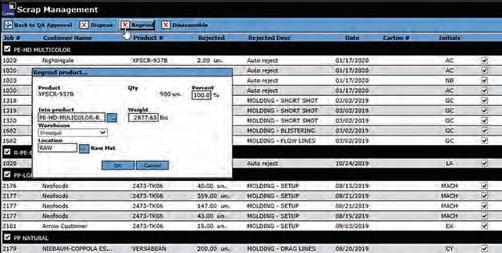
answers. “If you’re using minimal variations of material, separating that material into bins or zones and labelling each with a corresponding coloured placard helps avoid contamination and provides better value for those selling it,” Dunne said. “We recommend segregating regrind into three classifications: green, yellow, and red.” Green indicates very good quality regrind, Dunne continued, while yellow indicates lower quality or what had been produced using green regrind, and they can both be used for production with alternate recipes with green and yellow used at different percentages in the recipe to minimize production defects and maintain a normal production speed. “And red is either what’s sold to recyclers or what can be re-extruded with lost additives and filters to pelletize it in order to take out any contamination and add ingredients to generate near virgin-quality raw material,” he said.
Dunne also suggests using other low-tech strategies such as declaring all production rejects as they’re generated, grouping scrap by raw material type and colour, separating reusable from contaminated scrap, and coding regrind with a different SKU than virgin material to identify what type of regrind is being dealt with.
A RANGE OF SOLUTIONS At the top end of low-tech solutions, some processors have turned to spreadsheets, which industry experts say are well-suited for most simple situations involving one or two recipes. But this approach has obvious limits. “Manually cataloguing regrind material is time-consuming, costly, and inexact,” said Manuel Riano, CyFrame’s director of implementation. “Usually, any accumulated information is almost instantly out of date, since without access to real-time information, processors are never quite sure they have the right amount and type of regrind in stock to run the job effectively.”
For shops that place great importance on regrind tracking and that utilize multiple recipes, an ERP system is likely the best option. “A plastics-specific ERP solution can offer different tools to easily record rejected products or wasted material which will be turned into regrind,” said Rick Dunne. “When it comes to managing regrind, these systems provide detailed and current information about a specific customer or job and that customer’s unique requirements for the percentage of acceptable regrind or recycled material that goes into the mix. And for those selling regrind, ERP systems tell exactly how much of the scrap/remnants are reusable, along with the quantity and value of regrind on hand.”
ERP is a big investment, the experts
I CAN RUN THE SAME MATERIAL ACROSS ALL MY DIFFERENT VECOPLAN MACHINES.
– Reed Millett
Engineering/Equipment Manager, Pelican Packaging

Learn more about Pelican
Packaging’s business at vecoplanllc.com/Pelican
Shredding equipment options for all materials. Vecoplan heavy-duty shredders are built to handle the toughest plastics to keep your operation running. From stand-alone size reduction equipment to complete recycling systems, we have a solution for everyone. • Increase performance • Reduce application changeover time • Reduce maintenance time • Increase operational flexibility • Machines for all size businesses • Designed with the operator in mind
VAZ-1600 SHREDDER VIZ-1300 SHREDDER VTH-450 SHREDDER V-ECO-1300 SHREDDER
Learn more at vecoplanllc.com or contact us at info@vecoplanllc.com
IF YOU’VE PRODUCED IT, WE’VE PROCESSED IT.
(336) 447-3573 • info@vecoplanllc.com 5708 Uwharrie Road, Archdale, NC 27263 • www.vecoplanllc.com
note, and one size definitely doesn’t fit all, so it’s crucial for each processor to get the right system by determining their needs up front. “In addition to volume, the origin of the material must be determined, tracked, and made instantly accessible,” said Manuel Riano. “Also, virgin resins may include additives such as colour, fillers, lubricants, and stabilizers that might require a secondary drying step. Not all ERP systems will have the complete functionality that processors using regrind and recycled materials will require.”
If you don’t have or don’t want a full-blown ERP system, but you still want to track usage of regrind and other materials, Conair Group offers a system that uses SQL Server (structured query language) technology. “The software is readily available, or even free, and is commonly used in finance, inventory control, and other applications in many companies, so many processors are already familiar with it,” said Alan Landers, Conair’s blending product manager. “The system can be programmed to log all the materials being blended by resin type, recipe number, order number or any other factor, and then aggregates the data from all connected blenders so that users can quickly generate structured reports that tell them how much regrind was used by each blender or by all blenders plant-wide, today, last week, or over any period of time.”
MOVING IT AROUND Regrind can be exotic, but it’s also just another ingredient in your material mix that needs to be stored, conveyed, and metered. And there are probably more auxiliary products available now to perform these jobs than ever. Introduced last year, the GenesysNext drying system from Piovan is designed to work with recycled material, recycled PET in particular. “The dryer can automatically manage the drying process by setting all the critical parameters: from the process air flow rate to its dew point value, from the residence time to the temperature, maintaining optimum operating conditions even as hourly production and initial temperature and
Photo Credit: Maguire Products Inc.
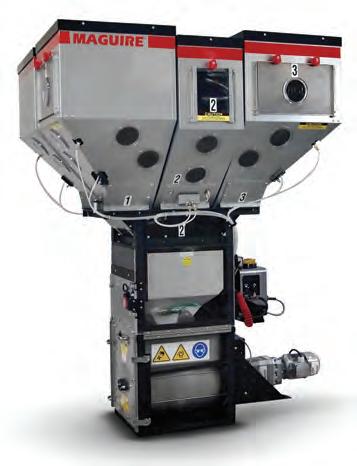
The 1200 series blenders from Maguire Products are said to offer expanded capacity for the use of regrind and post-consumer resin.
humidity conditions of the plastic granulate vary,” the company said.
Officials with Maguire Products Inc. said the company’s new 1200 series blenders, which can dispense up to 12 ingredients, offer expanded capacity for recycled and virgin-content production, making it a good option for processors looking to use more regrind and post-consumer resin along with virgin polymers. Among the ingredients the 1200 series blenders can dispense are pellets, powders, liquids, and poorly flowing ingredients like regrind, flake, wood flour, and talc filler. Each ingredient hopper has a dispensing device designed for a material in a specific form, the company said. And according to Brian Davis, general manager of Maguire Products Canada Inc., Maguire has other technologies that can track regrind usage, including feeders, totalizers, weigh dispensers, and the company’s Ultra resin dryers.
Wittmann Battenfeld’s new Ingrinder solution, designed for smaller injection molding machine models from the EcoPower and SmartPower series, removes the sprue directly during the injection process and passes it through an ejection chute integrated in the machine frame to a built-in and specially modified G-Max 9 granulator; a Wittmann vacuum conveyor then transports the recycled material via a two-component switch to the machine’s material hopper – the two-component switch enables alternating loading of virgin material and regrind in pre-set recipes that mix the materials before releasing them into the material hopper.
Conair’s TrueBlend blenders are said to offer a unique approach to controlling the metering of material, especially regrind. “In contrast with most other blender controls, the TrueBlend SB4 control always meters regrind first and then adds natural, colour, and other additives to match the material recipe,” said Alan Landers. “This way, the regrind ratio remains constant. And if the supply of regrind fluctuates, the blender can compensate by adding more natural.”
On the control side, the FlexTouch FTS control series from Novatec Inc. is said by the company to provide complete control in a fixed I/O package for evacuating regrind and conveying it to collection stations. “All grinder evacuation stations, recycle collection stations, pumps, and optional material line valves connect to a single enclosure via discrete wiring,” company officials said.
In the end, as with everything in life, it’s important to focus on what matters. If regrind is one of those things, there are big benefits to implementing the right tracking strategy for your unique situation. CPL
RESOURCE LIST Conair Group (Cranberry Township, Pa.); www.conairgroup.com; 724-584-5500
Dier International Plastics Inc. (Unionville,
Ont.); www.dierinternational.com; 416-219-0509
Industries Laferriere (Mascouche, Que.); www.industrieslaferriere.ca; 450-477-8880
Turner Group Inc. (Seattle, Wash.); www.turnergroup.net; 206-769-3707
CyFrame International Enterprises Inc.
(Saint-Laurent, Que.); www.cyframe.com; 514-693-0999
Maguire Products Canada Inc./Novatec Inc.
(Vaughan, Ont.); www.maguire.com; 905-879-1100 Piovan Canada Ltd. (Mississauga, Ont.); www.piovan.com; 905-629-8822 Wittmann Battenfeld Canada Inc. (Richmond Hill, Ont.); www.wittmann-group.com; 905-887-5355





